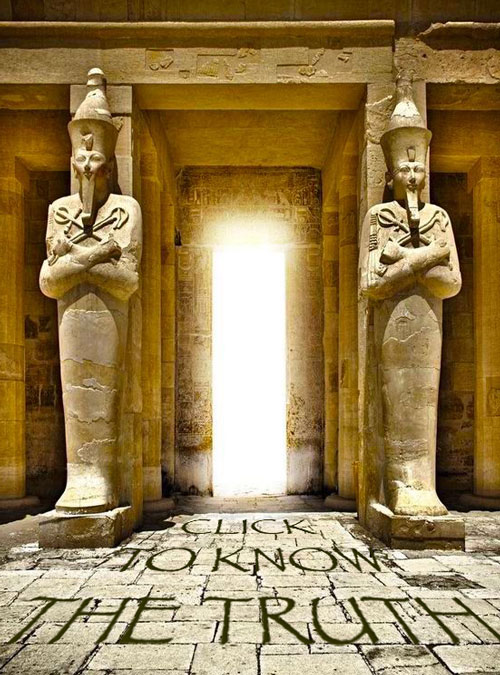Seshat
Seshat was known as the “mistress of measure”.

Initially, she gifted time to humanity which was governed by the menstrual cycle. Here we are reminded that a woman’s period makes its presence felt every 28 days just like the lunar month. So the Greek metra meaning “uterus” gave birth to the primal meter that we use in all forms of measurement. Indeed, many words expressing time come from this one: metronome, chronometer and so on.

Above: the uterine clock above Seshat’s head
Seshat was a Nubian name derived from Safeket which referred to the number seven. This comes from the seven energy centres of the human body. The green star above Seshat’s head was a nod to the lotus plant which informed the Royal Calendar. In other words, this flower is symbolic of the heptagram:

As a reminder of this, in the picture at top a frog is seated on a shenu representing fertility. This reference to Heqet and Horus speaks to the annual flooding of the Nile and the rebirth of time. Indeed, nocturnal frog croaks serenaded the rejuvenated Nile as it flooded every spring like a uterine clock. The symbolism of the frog stems from the tadpole’s similarity to human sperm. This is the “fertilizer” that brings about life—all types of abundance are attributed to Heqet and Horus.
Once upon a time, the flood of the Nile started in Philae at the beginning of June with a steady increase until the middle of July, when the flow of water became greater still. The river continued to rise until the beginning of September, when the level remained stationary for a period of about three weeks. In October it often rose again and reached its highest level. From this period on it began to subside.

Above: ovulation heralds the rebirth of time in the womb of the cosmos
Behind Seshat, in the background, is a Möbius strip. This is a surface with only one side (when embedded in three-dimensional Euclidean space) and only one boundary. In this case it has three twists, indicating the rebirth of time or Heqet’s triquetra:

The Universe tarot card has corner figures that represent the four fixed signs of the Zodiac—Scorpio, Aquarius, Leo and Taurus. They are symbolic of the four seasons and the four compass points. They are here to guide us from one phase to the next, bringing balance and harmony to our journey. Unsurprisingly, this card is based on earlier Egyptian artwork:

Time gives birth to space as discussed here and remains a more challenging medium to work with. This is because time requires an appreciation of implied wholes and cyclic patterns in order to reflect cosmic order. Space on the other hand, is focussed on linear parts and extant distances and uses words like perimeter and diameter. While this may seem odd, we remind you how Seshat’s Flower and Thoth’s Cube together yield timespace.
The temporal alignment of monuments was certainly important, associated with the conjunction of heavenly bodies. Seshat was responsible for establishing a proper relationship with time in society, or bringing it into harmony with the order of the universe. The “stretching of the cord” ritual reinforced the fact that the Earth was a temporal and spacial reflection of the heavens. Nowhere was this better illustrated than in the orientations and dimensions of Egyptian temples:
Above: a cinematic take on Denderah’s zodiac
The leopardess was sacred to Seshat because her rosettes looked like pentagons. No surprises then, that temple reliefs often show Seshat covered in five-pointed stars—a reference to Sopdet and her temporal influence over the Royal Calendar. The pentagon is formed from the conjunction of two analemmas.
 Time destroys all things—reducing mountains to rubble, oceans to deserts and civilisations to sand. Like a leopardess leaping from a tree at night, she is silent, invisible and deadly. A woman’s period, therefore, feels like a death of sorts that can include stomach cramps, sore breasts and chronic headaches.
Time destroys all things—reducing mountains to rubble, oceans to deserts and civilisations to sand. Like a leopardess leaping from a tree at night, she is silent, invisible and deadly. A woman’s period, therefore, feels like a death of sorts that can include stomach cramps, sore breasts and chronic headaches.
A woman has a finite amount of ova. Like an egg timer that ends in menopause, she will eventually face infertility. This waxing and waning described by the maiden, mother, cougar, crone cycle is a reminder of the ticking clock that all women must endure.

Above: was the measurement of time ever open to interpretation?
So Seshat is the mother of time and the silent witness to the passing of the seasons. She resides within every woman, where her heinous presence is felt every month. Despite being a symbol of death, Seshat invites maidens to become mothers every 28 days.
